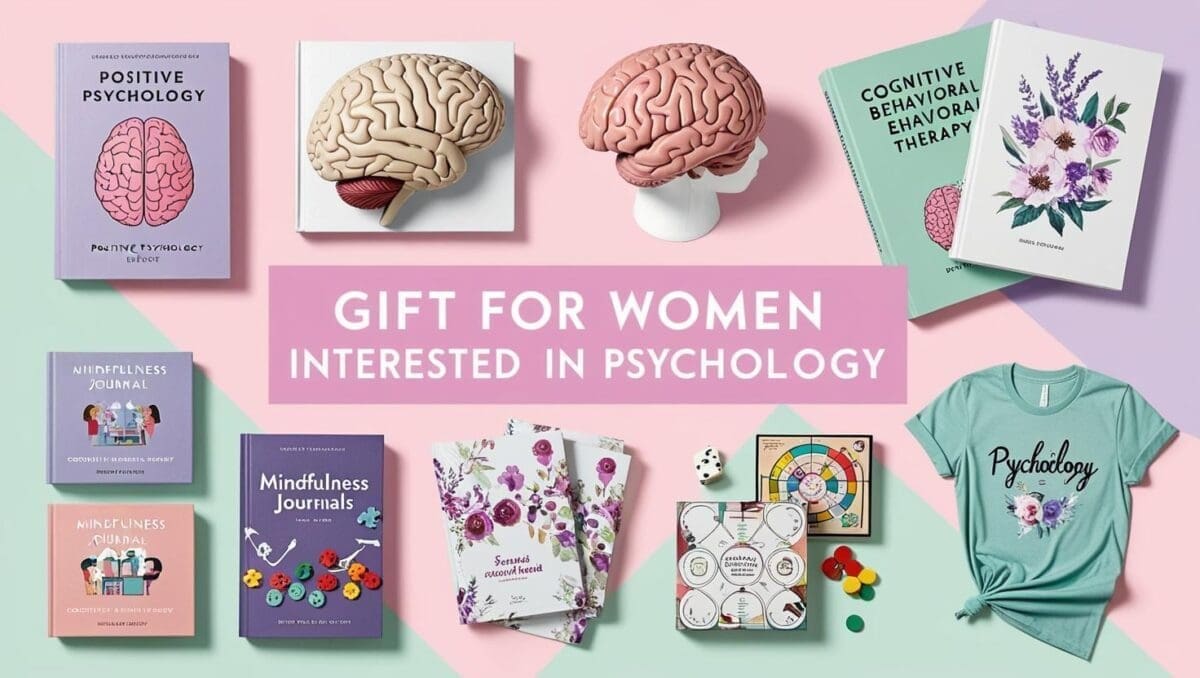Engaging kids with ADHD in creative activities can be a rewarding experience, and ceramic DIY projects are a fun way to spark their imagination. Working with clay not only offers a hands-on approach to art but also provides a sensory element that can be soothing and focus-enhancing. In this article, we’ll explore some simple ceramic projects that are easy to set up and perfect for young creators looking to express themselves while having a great time.
Engaging Projects to Spark Interest
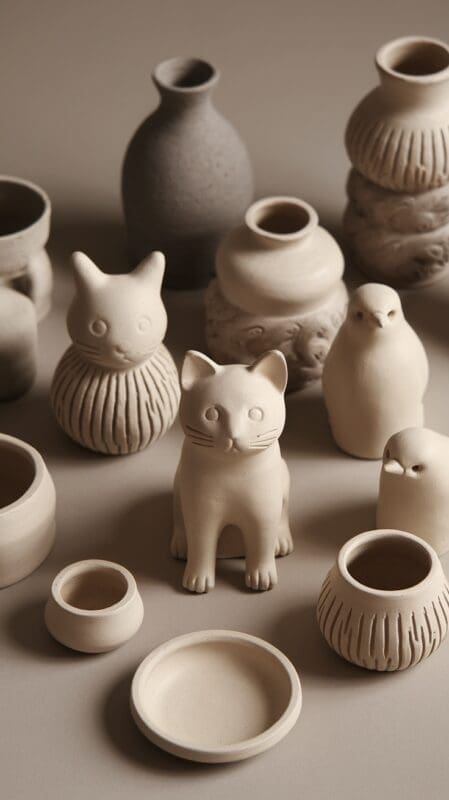
Ceramic projects can be a fantastic way to engage kids, especially those with ADHD. The image showcases a variety of unfinished ceramic pieces, including adorable animals and simple pots. These forms are inviting and can spark creativity.
Starting with basic shapes, like small bowls or animal figures, allows kids to express themselves without feeling overwhelmed. They can choose their favorite design and make it their own. The tactile nature of clay can also help kids focus their energy in a positive way.
As they work on their projects, encourage them to explore different textures and patterns. This can keep their interest alive and provide a sense of accomplishment when they see their finished pieces. Plus, decorating their creations with vibrant colors can be an exciting next step!
Using Color and Texture to Enhance Focus
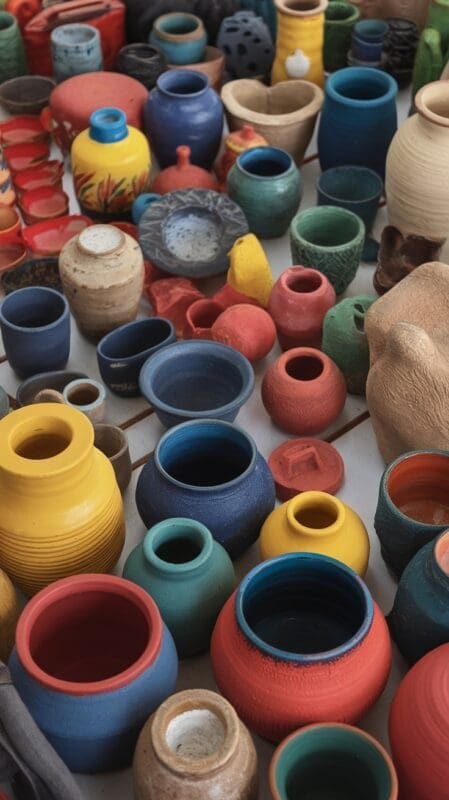
Ceramic DIY is a fun way for kids with ADHD to express themselves. The vibrant colors and various textures in ceramics can help capture their attention. Just look at the image filled with colorful pots and shapes!
Each piece has its own character, from bold reds to calming blues. These lively colors can stimulate creativity and encourage kids to focus on their projects. When children pick their favorite colors, they feel more connected to what they are creating.
Texture is another important part of the experience. Some pieces are smooth, while others are rough or patterned. This variety can keep kids engaged as they explore how different textures feel under their fingers. It’s a hands-on activity that encourages sensory exploration.
By combining colors and textures, children can find joy in creating. The more they enjoy the process, the easier it is for them to focus. Plus, there’s no right or wrong in art, so they can freely express their ideas without pressure.
Understanding ADHD and Its Impact on Creativity
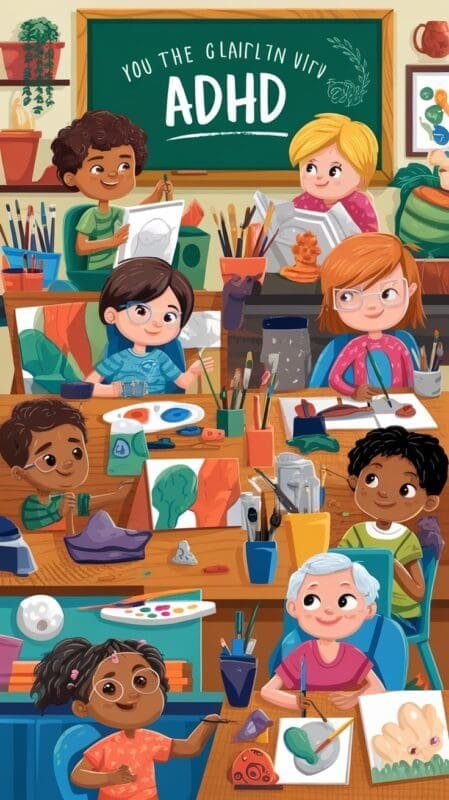
ADHD can make traditional learning environments challenging for kids. However, it can also spark unique creative abilities. The image shows a vibrant art class filled with children engaged in various creative activities, like painting and molding clay. This setting provides an excellent outlet for their energy and imagination.
Each child in the image is focused on their projects, showcasing a range of artistic expressions. This highlights how hands-on activities, like ceramic DIY, can captivate kids with ADHD by allowing them to explore their creativity without strict boundaries. The chaos of art supplies and the various textures involved can be particularly appealing.
Creativity often thrives in environments that are less structured. In the image, the children are free to experiment with colors and shapes. This freedom can help them channel their restlessness into productive endeavors, leading to a sense of accomplishment. Art projects, especially DIY ceramics, not only engage their minds but also provide a relaxing and fulfilling experience.
Incorporating Structure into Creative Sessions
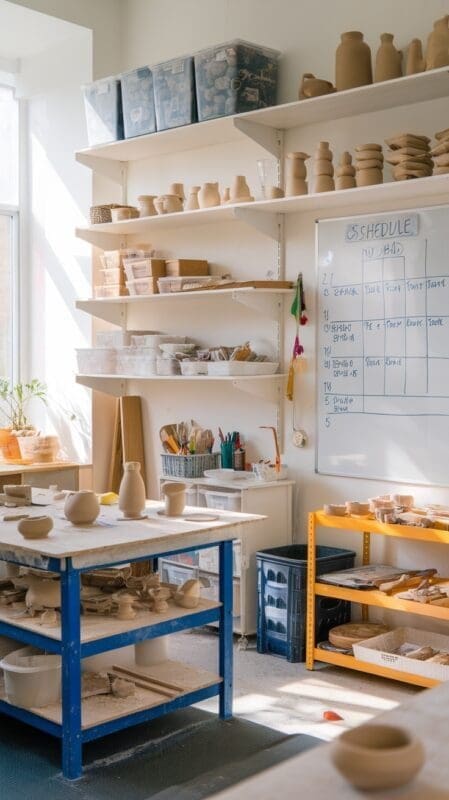
Creating art can be a beautiful outlet for children, especially those with ADHD. In a ceramic studio like the one in the image, structure helps guide them through the creative process. The setup shows shelves filled with various supplies, all neatly organized. This organization can make it easier for kids to focus on their projects. Having a clear layout allows them to see what tools and materials are available.
Setting a schedule helps too. The whiteboard visible shows a plan for activities, which can be reassuring for children who thrive on routine. Knowing what to expect can reduce anxiety and help them stay engaged. You can even break down the ceramic-making process into steps. For example, start with shaping the clay, then move onto painting. This step-by-step approach prevents overwhelm and encourages a sense of accomplishment after each part is completed.
Using timers can also add a fun layer to the creative process. Set a timer for each step, giving kids a clear goal to achieve within a set timeframe. Once the timer goes off, they can take a short break before moving to the next task. This balance of creativity and structure can make for a fulfilling experience, allowing kids to express themselves while staying focused. Incorporating these elements can turn a simple craft session into a fun, engaging learning experience!
Choosing the Right Ceramics for Kids
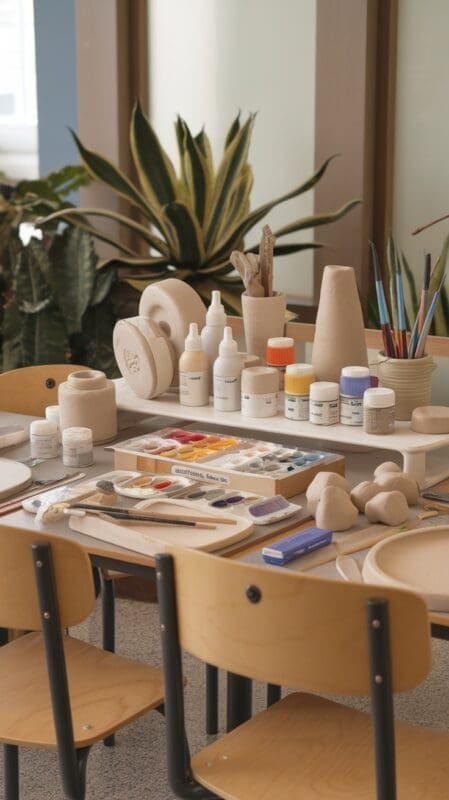
When it comes to ceramics for kids, especially those with ADHD, selecting the right materials can make a big difference. The image shows a vibrant workspace filled with various ceramic pieces and tools, making it an inviting setup for creativity. The soft colors of the unglazed ceramics are perfect for little hands to mold and shape.
Look for air-dry clay or polymer clay, which are easy to use and don’t require a kiln. These types allow kids to focus on their creations without worrying about additional steps. The image illustrates a variety of small ceramic forms, all ready to be painted and designed.
Consider including colorful paints and brushes, just like in the image, which can spark imagination. Bright colors can help keep children engaged and excited about their projects. It’s important to have non-toxic materials to ensure safety while they explore their artistic side.
Another fun option visible in the picture is using simple tools like rolling pins and shape cutters. These can assist kids in creating unique designs without much hassle. Giving them the tools to express themselves can lead to wonderful creations and a sense of achievement.
Promoting Teamwork Through Group Projects
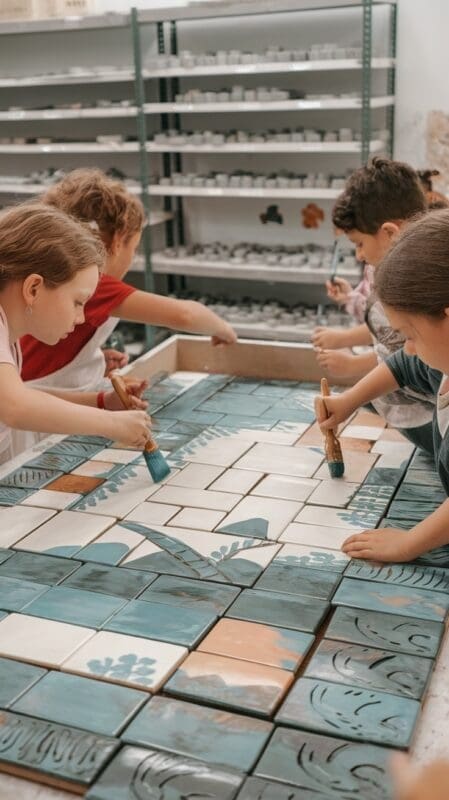
In the image, a group of children is busy working together on a ceramic project. They are painting colorful tiles with various designs, each contributing their unique touch. This collaborative effort is a fantastic way to promote teamwork among kids, especially those with ADHD.
When kids engage in group projects, they learn to communicate and share ideas. Each child brings different strengths to the table, and this diversity can spark creativity. This is particularly beneficial for children who might struggle with focus, as they can stay engaged by working alongside their peers.
Involving kids in a hands-on activity like ceramic painting helps them practice patience and cooperation. They can encourage one another, share supplies, and make decisions together. This interaction not only fosters social skills but also boosts their confidence as they see the results of their combined efforts.
Plus, when a project is completed, kids can take pride in what they’ve accomplished as a team. This sense of achievement can further motivate them to participate in future group activities. Overall, ceramic DIY projects offer a fun and engaging way to build teamwork skills.
Simple Ceramic Techniques for Beginners
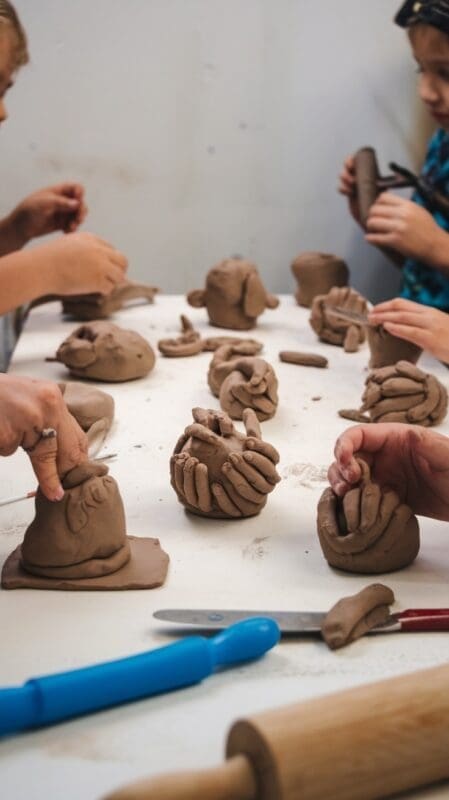
Ceramic projects can be a fun and engaging way for kids to express their creativity. The image above shows children working with clay, shaping their creations with their hands. This hands-on approach is especially beneficial for kids with ADHD, as it allows them to focus and channel their energy into something tangible.
One simple technique is hand-building. Kids can start by rolling clay into balls or coils. They can then pinch, press, or pull the clay to create different shapes. This method is straightforward and doesn’t require any special tools, making it perfect for beginners.
Another fun technique is slab construction. Kids can flatten the clay using a rolling pin, just like in the image, and cut out shapes to assemble. This can lead to creative designs like tiles, plates, or even small sculptures. The tactile nature of the clay keeps kids engaged and provides a sensory experience that can be calming.
Using simple tools like a knife or a textured roller can add interesting details to their projects. Kids can carve patterns or create textures that make their pieces unique. Also, remember to encourage them to let their ideas flow. There is no right or wrong in ceramic art!
Benefits of Ceramic DIY Projects for Children
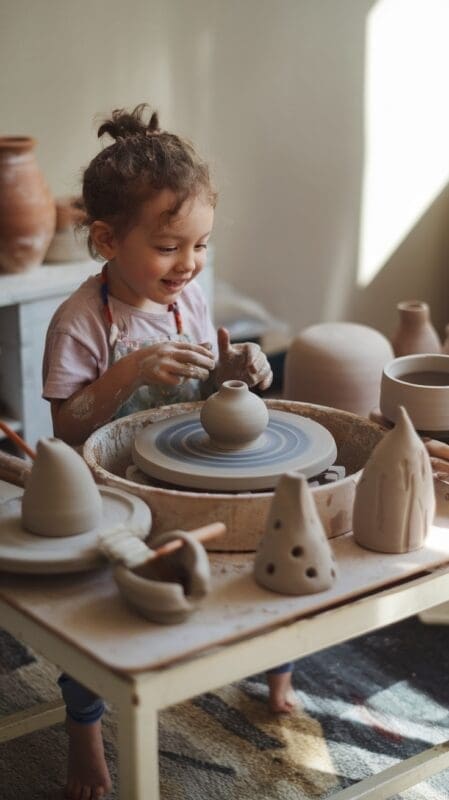
Ceramic DIY projects can be a fun and engaging way for kids to express themselves. In the image, a young child is happily working with clay, showing how these hands-on activities can spark joy and creativity. The process of molding and shaping the clay offers a tactile experience that is especially beneficial for children with ADHD.
Working with ceramics can help improve focus and concentration. As kids mold the clay, they learn to pay attention to their movements and the details of their creations. This focus can be incredibly helpful for children who often find it challenging to concentrate on tasks.
Additionally, ceramics can enhance fine motor skills. As seen in the image, the child is using their hands to shape a pot, which requires precise movements. This can promote hand-eye coordination and dexterity, key skills for children as they grow.
Moreover, these projects allow kids to express their feelings and ideas in a creative way. The freedom to create something unique can boost their self-esteem. When they see their finished piece, it can be a source of pride and accomplishment.
Ceramic DIY activities also encourage patience and perseverance. The process of shaping, drying, and glazing takes time. This can teach children the value of working towards a goal and the satisfaction that comes from completing a project.
Creating a Safe and Inspiring Workspace
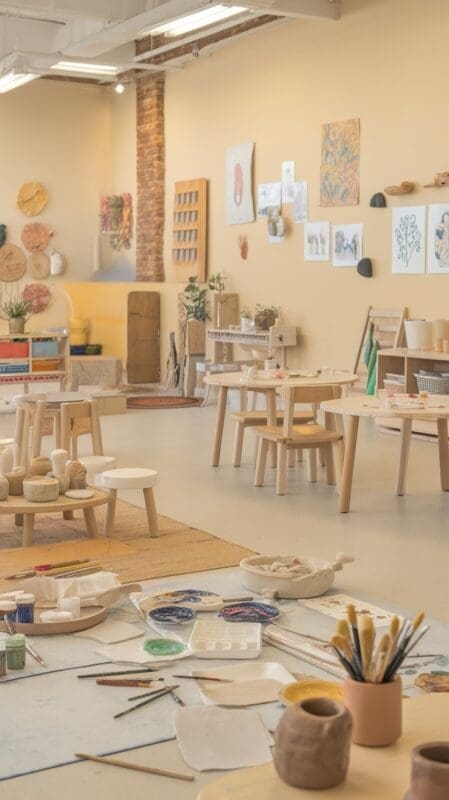
When it comes to ceramic DIY projects for kids with ADHD, having the right workspace is key. The image shows a bright and airy space filled with natural light, which is excellent for creativity. The light-colored walls and wooden furniture create a calming atmosphere, perfect for children to feel relaxed as they dive into their projects.
It’s important to keep the workspace organized. Notice the neatly arranged tables and tools. This setup helps kids focus better. Having everything in its place reduces distractions and lets their minds wander into creativity. The variety of colors in the paints and clays can also inspire new ideas, making the workspace feel vibrant and inviting.
Safety is another big factor. The image suggests a clean area with soft flooring to prevent slips and falls. Kids can move around comfortably without worrying about sharp edges or clutter. Providing easy access to materials and tools also gives children a sense of independence as they explore their artistic skills.
Lastly, incorporating elements of nature, like the plants in the background, adds a fresh touch. Nature can have a grounding effect and helps to focus the mind. It’s an excellent way to create a space that is not just functional, but also nurturing for young artists.
Celebrating Achievements with Ceramic Shows
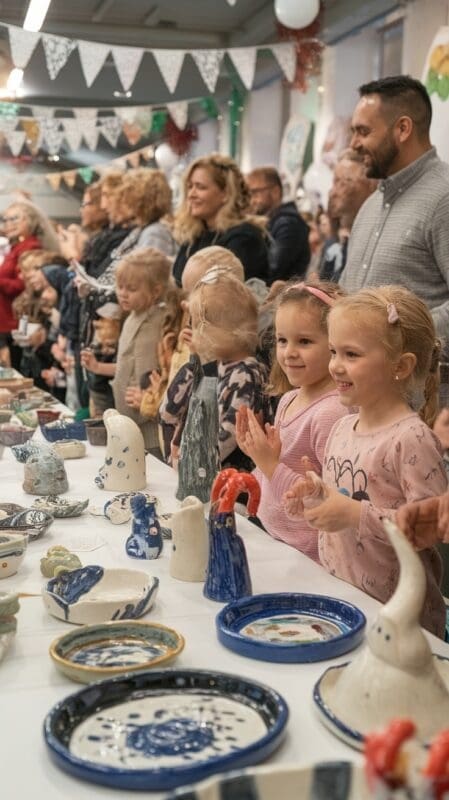
Ceramic shows can be a fantastic way to celebrate the achievements of kids, especially those with ADHD. These events allow children to showcase their hard work and creativity in a fun and supportive environment. In the image, you can see children clapping and smiling as they proudly display their ceramic creations. Their excitement is palpable, and it’s clear that they feel valued.
Participating in a ceramic show gives kids the chance to express themselves. It helps them focus on their projects and see the results of their efforts. The pride they feel when their creations are admired by others can boost their self-esteem and motivate them to keep creating.
Additionally, these shows offer a sense of community. Kids and their families gather to celebrate not just the art, but also each other. It’s a wonderful opportunity for social interaction, which can be particularly beneficial for children with ADHD. Engaging with others and receiving positive feedback helps them feel connected.
Hosting a ceramic show can be simple. Set up tables for displaying the artworks, invite families and friends, and create a festive atmosphere with decorations. Incorporating activities like a hands-on pottery station can keep kids involved and excited. This blend of creativity and celebration makes ceramic shows a meaningful experience for everyone.

About the Author
Hi, I’m Eve, a former school counselor with a master’s degree in School Psychology and a passionate advocate for children and families navigating sensory challenges. As a mom of children with sensory sensitivities, I deeply understand the journey special-needs parents face, and I dedicate myself to researching and sharing practical solutions to help children thrive and feel comfortable in their bodies. My goal is also to empower counselors, therapists, and psychologists with creative strategies and supportive resources to enrich their everyday practice. When I’m not writing or exploring new therapeutic approaches, you’ll find me spending quality time with my family and continually seeking inspiration from everyday moments.


